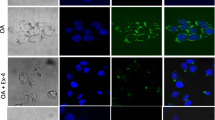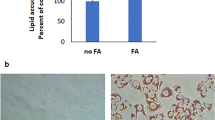Abstract
Nonalcoholic fatty liver is characterized by the abnormal accumulation of triglycerides within hepatocytes, resulting in a steatotic liver. Glucagon-like peptide 1 and its analog exendin-4 can ameliorate certain aspects of this syndrome by inducing weight loss and reducing hepatic triglyceride accumulation, but it is unclear whether these effects result from the effects of glucagon-like peptide 1 on the pancreas, or from direct action on the liver. This study investigated the direct action and putative cellular mechanism of exendin-4 on steatotic hepatocytes in culture. Steatosis was induced in cultured HepG2 human hepatoma cells by incubation in media supplemented with 2 mM each of linoleic acid and oleic acid. Steatotic hepatocytes were then pre-incubated in the protein kinase A inhibitor H89 for 30 min, then treated with exendin-4 over a period of 24 h. Cell viability and triglyceride content were characterized by a TUNEL assay and AdipoRed staining, respectively. Our results showed that steatotic cells maintained high levels of intracellular triglycerides (80%) compared to lean controls (25%). Exendin-4 treatment caused a significant reduction in intracellular triglyceride content after 12 h that persisted through 24 h, while protein kinase A inhibitors abolished the effects of exendin-4. The results demonstrate the exendin-4 induces a partial reduction in triglycerides in steatotic hepatocytes within 12 h via the GLP-1 receptor-mediated activation of protein kinase A. Thus, the reduction in hepatocyte triglyceride accumulation is likely driven primarily by downregulation of lipogenesis and upregulation of β-oxidation of free fatty acids.




Similar content being viewed by others
References
Angulo P (2002) Nonalcoholic fatty liver disease. NE J Med 346:1221–1231
Armstrong MJ, Gaunt P, Aithal GP, Barton D, Hull D, Parker R, Hazlehurst JM, Guo K, Abouda G, Aldersley MA, Stocken D (2016) Liraglutide safety and efficacy in patients with non-alcoholic steatohepatitis (LEAN): a multicentre, double-blind, randomised, placebo-controlled phase 2 study. Lancet 387:679–690
Baggio LL, Drucker DJ (2007) Biology of incretins: GLP-1 and GIP. Gastroenterol 132:2131–2157
Battaglia M, Pozzi D, Crimaldi S, Parasassi T (1994) Hoechst 33258 staining for detecting mycoplasma contamination in cell cultures: a method for reducing fluorescence photobleaching. Biotech Histochem 69:152–156
Ben-Shlomo S, Zvibel I, Shnell M, Shlomai A, Chepurko E, Halpern Z, Barzilai N, Oren R, Fishman S (2011) Glucagon-like peptide-1 reduces hepatic lipogenesis via activation of AMP-activated protein kinase. J Hepatol 54:1214–1223
Brown MS, Goldstein JL (2008) Selective versus total insulin resistance: a pathogenic paradox. Cell Metab 7:95–96
Cawano Y, Cohen DE (2013) Mechanisms of hepatic triglyceride accumulation in non-alcoholic fatty liver disease. J Gastroenterol 48:434–441
Ding X, Saxena NK, Lin S, Gupta NA, Anania FA (2006) Exendin-4, a glucagon-like protein-1 (GLP-1) receptor agonist, reverses hepatic steatosis in ob/ob mice. Hepatology 43:173–181
Göke R, Fehmann HC, Linn T, Schmidt H, Krause M, Eng J, Göke B (1993) Exendin-4 is a high potency agonist and truncated exendin-(9-39)-amide an antagonist at the glucagon-like peptide 1-(7-36)-amide receptor of insulin-secreting beta-cells. J Biol Chem 268:19650–19655
Greenspan P, Mayer EP, Fowler SD (1985) Nile red: a selective fluorescent stain for intracellular lipid droplets. J Cell Biol 100:965–973
Guguen-Guillouzo C, Guillouzo A (2010) General review on in vitro hepatocyte models and their applications. In: Maurel P (ed) Hepatocytes: methods and protocols. Springer, New York, pp 1–40
Gupta NA, Mells J, Dunham RM, Grakoui A, Handy J, Saxena NK, Anania FA (2010) Glucagon-like peptide receptor is present on human hepatocytes and has a direct role in decreasing hepatic steatosis in vitro by modulating element of the insulin signaling pathway. Hepatology 51:1584–1592
Horton JD, Goldstein JL (2002) SREBPs: activators of the complete program of cholesterol and fatty acid synthesis in the liver. J Clin Invest 109:1255–1131
Jacome-Sosa M, Parks EJ (2014) Fatty acid sources and their fluxes as they contribute to plasma triglyceride concentrations and fatty liver in humans. Curr Opin Lipidol 25:213–220
Khan S, Kumar S, Jena G (2016) Valproic acid reduces insulin-resistance, fat deposition and FOXO1-mediated gluconeogenesis in type-2 diabetic rat. Biochimie 125:42–52
Lee J, Hong SW, Chae SW, Kim DH, Choi JH, Bae JC, Park SE, Rhee EJ, Park CY, Oh KW, Park SW (2012) Exendin-4 improves steatohepatitis by increasing Sirt1 expression in high-fat diet-induced obese C57BL/6J mice. PLoS One 7:e31394
López-Delgado MI, Morales M, Villanueva-Peñacarrillo ML, Malaisse WJ, Valverde I (1998) Effects of glucagon-like peptide 1 on the kinetics of glycogen synthase A in hepatocytes from normal and diabetic rats. Endocrinol 139:2811–2817
Matsumoto M, Pocai A, Rossetti L, DePinho RA, Accili D (2007) Impaired regulation of hepatic glucose production in mice lacking the forkhead transcription factor Foxo1 in liver. Cell Metabol 6:208–216
Moon YA, Ochoa CR, Mitsche MA, Hammer RE, Horton JD (2014) Deletion of ELOVL6 blocks the synthesis of oleic acid but does not prevent the development of fatty liver or insulin resistance. J Lipid Res 55:2597–2605
Nativ NI, Yarmush G, So A, Barminko J, Maguire TJ, Schloss R, Berthiaume F, Yarmush ML (2014) Elevated sensitivity of macrosteatotic hepatocytes to hypoxia/reoxygenation stress is reversed by a novel defatting protocol. Liver Transpl 20:1000–1011
Portillo-Sanchez P, Cusi K (2016) Treatment of nonalcoholic fatty liver disease (NAFLD) in patients with type 2 diabetes mellitus. Clin Diabet Endocrinol 2:9
Ress C, Kaser S (2016) Mechanisms of intrahepatic triglyceride accumulation. World J Gastroenterol 22:1664–1673
Taher J, Baker CL, Cuizon C, Masoudpour H, Zhang R, Farr S, Naples M, Bourbon C, Pausova Z, Adeli K (2014) GLP-1 receptor agonism ameliorates hepatic VLDL overproduction and de novo lipogenesis in insulin resistance. Molec Metabol 3:823–833
Thonpho A, Sereeruk C, Rojvirat P, Jitrapakdee S (2010) Identification of the cyclic AMP responsive element (CRE) that mediates transcriptional regulation of the pyruvate carboxylase gene in HepG2 cells. Biochem Biophys Res Comm 393:714–719
Utzschneider KR, Kahn SE (2006) The role of insulin resistance in nonalcoholic fatty liver disease. J Endocrin Metab 91:4753–4761
Wang H, Zhao M, Sud N, Christian P, Shen J, Song Y, Pashaj A, Zhang K, Carr T, Su Q (2016) Glucagon regulates hepatic lipid metabolism via cAMP and Insig-2 signaling: implication for the pathogenesis of hypertriglyceridemia and hepatic steatosis. Sci Rep 6:32246
Acknowledgements
This work was pioneered by AC as part of the Cellular Bioengineering Summer Undergraduate Research Program at Rutgers University (supported by the NSF EEC 1262924). This work was supported by the Ellen Miller Casey Award to AC, Research as a High Impact Practice student funding program awarded to GH, and internal funds from the University of Scranton awarded to GG.
Author information
Authors and Affiliations
Corresponding author
Additional information
Editor: Tetsuji Okamoto
Rights and permissions
About this article
Cite this article
Chen-Liaw, A.Y., Hammel, G. & Gomez, G. Inhibition of exendin-4-induced steatosis by protein kinase A in cultured HepG2 human hepatoma cells. In Vitro Cell.Dev.Biol.-Animal 53, 721–727 (2017). https://doi.org/10.1007/s11626-017-0181-y
Received:
Accepted:
Published:
Issue Date:
DOI: https://doi.org/10.1007/s11626-017-0181-y




